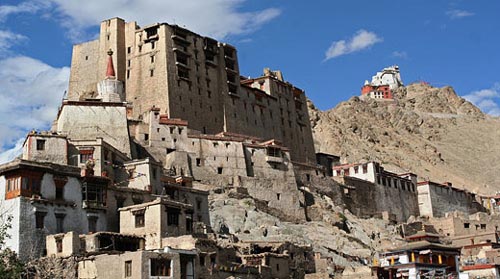Leh Palace

Information on Leh Palace (Ladakh, Jammu and Kashmir) - History & Architecture
The Leh Palace was basically a royal palace previously which commanded a view of the Ladakhi Himalayan town that is Leh. The palace is a replica of the Potala Palace which is situated in Lhasa, Tibet and was constructed by King Sengge Namgayal in the period of 17th century. The palace has nine floors and the top floors were supposed to be the residence of the royal family members and the lower storeys housed store rooms as well as stables. The Leh palace was deserted during the middle of the 19th century when the forces or army of Dogra conquered and took control of the Ladakh region in Jammu and Kashmir and the royal family was left with no option and so, shifted to the Stok Palace.
Leh Palace Architecture
The design of the Leh palace involves a conventional Tibetan architectural pattern prevalent during the medieval period. The chief characteristics of this particular architectural pattern include enormous buttressed walls accompanied with suspended wooden balconies. The huge palace with nine floors can almost be viewed from most of the places in Leh. The Leh Palace used to be amongst one of the most soaring structures across the globe during the period of 1553 at the time of its construction. The design of the palace is stated to be simple yet magnificent and is believed to emanate certain degree of grandeur that is subtle except for being intimidating. The palace stands tall on the top of a rocky mountain and is mad of mud, sand, stones and woods. The solid or substantial mud as well as wood walls is known to keep the palace cool by preventing the heat from entering the palace. The palace is known to include numerous small sections, passageways and a few big rooms.
Leh Palace History
The initiation of the construction work for the palace on top of the Tsemo Hill was made by Tsewang Namgyal who is believed to be the pioneer of the Namgyal dynasty of Ladakh. The construction work in relation to the palace started in the year 1553 and was finished by Tsewang Namgyal's nephew Singe Namgyal. The impressive Leh Palace was constructed during the 17th century as a regal residence for the King Singe Namgyal. Although, the palace is supposed to be in ruins presently but, yet reflects an old classy and urbane charm along with offering stunning sights of the snow capped mountains and countryside. There even used to be a monastery which had a statuette of Buddha within the palace. Presently, the bigger rooms and the passageways serve as exhibition hallways that demonstrate old paintings as well as photographs of Leh. The roof of the palace has been made with mud and thick clusters of small size woods between sand and mud can be observed exclusively on the roof. The interiors of the palace rules out the inclusion of any kind of imposing elements apart from the splendour size as well as remarkable view. The Leh palace is considered to be an architectural marvel as the huge palace stands on a sloping rocky mountain and have been standing strong for the last 400 years.
Leh Palace Tourism Importance
The Leh palace is considered to be a cultural as well as religious centre by the Buddhist and the palace is supposed to be quite a revered and significant part of the Leh's aspect of tourism. Therefore, the Leh palace attracts a significant number of tourists nationally as well as globally.
- Andaman Nicobar Monuments
- Andhra Pradesh Monuments
- Assam Monuments
- Bihar Monuments
- Chhattisgarh Monuments
- New Delhi Monuments
- Goa Monuments
- Gujarat Monuments
- Haryana Monuments
- Himachal Pradesh Monuments
- Jammu and Kashmir Monuments
- Karnataka Monuments
- Kerala Monuments
- Madhya Pradesh Monuments
- Maharashtra Monuments
- Odisha Monuments
- Punjab Monuments
- Rajasthan Monuments
- Tamil Nadu Monuments
- Telangana Monuments
- Uttar Pradesh Monuments
- West Bengal Monuments